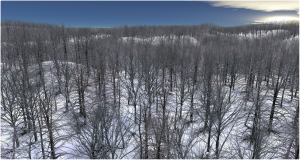 Multiresolution plant geometrical Lod models for real-time natural virtual scenes rendering
Multiresolution plant geometrical Lod models for real-time natural virtual scenes rendering
Keywords — level of detail, virtual forests, real time, branch models, tree foliage simplification, geometrical compression; multi-resolution; rendering; GPU-oriented
Plants geometrical models are important objects in virtual environments showing high complexity of shape and structure. With our partners CASIA and BJFU in China, we developed level of detail (LOD) plant geometric models both for branches and foliage. Such plant LoD models allow interactive forest rendering.
Fig. 1: Four simplified models of a 40 years old black poplar with their corresponding compression ratios.
- We developed a new foliage simplification framework. By an uneven subdivision of the tree crown volume, the cost for LOD model construction is drastically reduced. With a GPU-oriented design of LOD storage structure for foliage, the costly hierarchical traversal of a binary tree is replaced by a sequential lookup of an array. The structure also decreases the communication between the CPU and the GPU in rendering. In addition, Leaf density is introduced to adapt compression to the local distribution of leaves, so that more visually relevant details are kept. According to foliage nature (broad leaves or needles), higher compression are finally reached using mixed polygon/line models.
Fig. 2: Bird’s-eye view over a virtual forest (2010). The scene consists in 16888 trees, 311 trees are in the viewing frustum, the foliage compression ratio is below 0.5% , FPS is 67.
- We also developed a level of detail (LOD) model for tree branches. Starting from a skeletal representation of a tree, we fit polygon meshes of various densities to the skeleton while the mesh density is adjusted according to the required visual fidelity. For distant models, these branch meshes are gradually replaced with semi-transparent lines until the tree recedes to a few lines. Construction of these complete LOD models is guided by error metrics to ensure smooth transitions between adjacent LOD models. We then present an instancing technique for discrete LOD branch models with polygon meshes and semi-transparent lines. Our technique reduces the number of draw calls in GPU and increases rendering performance.
Fig. 3: A bird’s-eye view of a dense forest without leaves (with 11 820 trees and 4 429 236 primitives in the view, where the FPS is 22).
- On both developments, we emphasized three major problems : the time consumption in LOD model construction and extraction, the balance between visual effect and data compression, and the time consumption in the communication between Central Processing Unit (CPU) and Graphics Processing Unit (GPU).
Publications
QingQiong Deng, Xiaopeng Zhang, Gang Yang, Marc Jaeger. Multiresolution foliage for forest rendering, in COMPUTER ANIMATION AND VIRTUAL WORLDS, 2010, Vol. 21, No 1, John Wiley and Sons, pp. 1-23
Zang, X.-P., Bao, G.-B., Meng, W.-L., Jaeger, M., Li, H.-J., Deussen, O., and Chen, B.-Q., 2017. Tree Branch Level of Detail Models for Forest Navigation. Computer Graphics Forum, 2017, DOI: 10.1111/cgf.130 http://onlinelibrary.wiley.com/doi/10.1111/cgf.13088/full
Contact : i2p computer graphics



